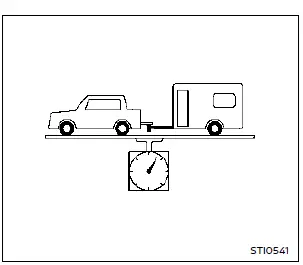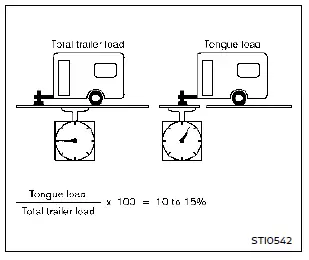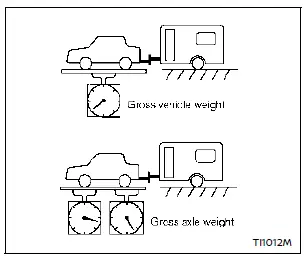Nissan Rogue (T33) 2021-Present OwnerŌĆÖs Manual & User Guide: Maximum load limits
Maximum trailer loads
Never allow the total trailer load to exceed the value listed in the ŌĆ£Towing Load/SpecificationŌĆØ chart in this section. The total trailer load is the combined weight of the trailer itself plus all cargo inside it. For Nissan Rogue owners, staying within these limits is essential for safe towing performance.
The maximum Gross Combined Weight Rating (GCWR) must also not exceed the value shown in the ŌĆ£Towing Load/SpecificationŌĆØ chart.

The GCWR represents the combined weight of the towing vehicle (including passengers and cargo) plus the total trailer load. Exceeding these weights or using improper towing equipment may negatively affect handling, braking, and overall performance of your Nissan Rogue.
Your vehicleŌĆÖs towing ability is influenced not only by maximum load ratings but also by the terrain and conditions in which you plan to tow.
Tow weights acceptable for smooth highway driving may need to be reduced in low-traction environments, such as wet grass, gravel, or slippery boat ramps.
High temperatures can also affect towing capability. For example, towing a heavy trailer uphill in hot weather can raise engine and transmission temperatures. On a Nissan Rogue, this may trigger the transmission high-fluid-temperature protection mode, which automatically reduces engine power to prevent damage. During this time, vehicle speed may decrease under heavy load.
Plan your route and towing conditions carefully, considering trailer load, weather, and road gradients.
WARNING
Overheating can reduce engine power and lower vehicle speed. If your Nissan Rogue cannot maintain a safe speed, pull over to a safe location, allow the engine to cool, and wait for normal operation to return.
CAUTION
Any vehicle damage caused by improper towing procedures is not covered by NISSAN warranties.

Tongue load
When using either a weight-carrying or weight-distributing hitch, maintain the tongue load between 10ŌĆō15% of the total trailer load, unless the trailer manufacturer specifies otherwise. The correct tongue load must also fall within the limits shown in the ŌĆ£Towing Load/SpecificationŌĆØ chart. If tongue load is too high, redistribute cargo to bring the load into the correct range for stable towing with a Nissan Rogue.
Maximum Gross Vehicle Weight (GVW)/maximum Gross Axle Weight (GAW)

The GVW of the towing vehicle must not exceed the GVWR listed on the F.M.V.S.S./C.M.V.S.S. certification label. GVW includes the weight of the unloaded vehicle, passengers, luggage, trailer tongue load, hitch, and optional equipment. Additionally, the front and rear axle loads must not exceed their respective GAWR values. These rules apply fully when towing with a Nissan Rogue.
Towing capacities are calculated assuming a base vehicle with a driver and required equipment. Adding cargo, passengers, or accessories increases overall weight and reduces towing and tongue load capacity.
The vehicle and trailer must be weighed to ensure compliance with GVWR, front/rear GAWR, GCWR, and towing capacity limits.
These measurements can be taken at platform-type scales found at truck stops, weigh stations, material supply centers, or salvage yards.
To calculate the available payload capacity for tongue/king pin load, follow this procedure:
1. Locate the GVWR on the F.M.V.S.S./C.M.V.S.S. certification label.
2. Weigh your vehicle with passengers and cargo as normally loaded when towing.
3. Subtract the actual vehicle weight from the GVWR. The remaining value is the maximum allowable tongue/king pin load.
To determine available towing capacity, follow this procedure:
1. Find the GCWR for your vehicle in the ŌĆ£Towing Load/SpecificationŌĆØ chart.
2. Subtract the actual loaded vehicle weight from the GCWR. The remainder is the maximum towing capacity for your Nissan Rogue.
To calculate the Gross Trailer Weight, weigh the trailer with all typical cargo and equipment. Confirm that the Gross Trailer Weight does not exceed the trailerŌĆÖs own rating and is within your available towing capacity.
Weigh the front and rear trailer axles separately to ensure their loads do not exceed the corresponding GAWR values listed on the certification label. Cargo in either the vehicle or trailer may need to be redistributed to stay within allowed limits.
Example:
- Gross Vehicle Weight (GVW) as weighed on a scale ŌĆö including passengers, cargo, and hitch ŌĆö 6,350 lb (2,880 kg). This would represent a typical loaded condition for a Nissan Rogue when preparing for towing.
- Gross Vehicle Weight Rating (GVWR) from the F.M.V.S.S./C.M.V.S.S. certification label ŌĆö 7,250 lb (3,289 kg).
- Gross Combined Weight Rating (GCWR) from the ŌĆ£Towing Load/SpecificationŌĆØ chart ŌĆö 15,100 lb (6,849 kg).
- Maximum trailer towing capacity from the ŌĆ£Towing Load/SpecificationŌĆØ chart ŌĆö 9,100 lb (4,128 kg).
GVWR: 7,250 lb. (3,289 kg)
GVW: ŌłÆ 6,350 lb. (2,880 kg)
Available for tongue weight = 900 lb (409 kg)
GCWR: 15,100 lb (6,849 kg)
GVW: ŌłÆ 6,350 lb (2,880 kg)
Capacity available for towing = 8,750 lb (3,969 kg)
Available tongue weight: 900 lb (409 kg) / Available capacity: 8,750 lb (3,969 kg) = 10% tongue weight
The available towing capacity may be less than the maximum towing capacity because of the total passenger and cargo weight inside the vehicle. Nissan Rogue owners should always consider actual load conditions when calculating safe towing limits.
Keep trailer tongue weight within 10ŌĆō15% of the total trailer weight or follow the trailer manufacturerŌĆÖs specific recommendation.
If the tongue load becomes excessive, redistribute the trailer cargo until proper tongue weight is achieved. Never exceed the maximum tongue weight value listed in the ŌĆ£Towing Load/SpecificationŌĆØ chart, even if your available tongue capacity appears higher than 15%. If tongue weight falls below 10%, reduce the total trailer weight accordingly.
Always confirm that all available capacities are within the vehicleŌĆÖs ratings before towing.
 Basic information
Basic information
WARNING
Improper loading or overloading of a trailer can negatively impact vehicle handling, braking, and overall performance, increasing the risk of an accident.
CAUTION
Do not tow a trailer or ha ...
 Towing load/specification
Towing load/specification
WARNING
The towing capacities in this manual are general guidelines. Actual safe towing capacity of your Nissan Rogue depends on factory or dealer-installed equipment, passenger load, and cargo weight ...
Other materials:
Precaution
Precaution for Supplemental Restraint System (SRS) "AIR BAG" and "SEAT
BELT
PRE-TENSIONER"
The Supplemental Restraint System such as ŌĆ£AIR BAGŌĆØ and ŌĆ£SEAT BELT PRE-TENSIONERŌĆØ,
used along
with a front seat belt, helps to reduce the risk or severity of injury to the
...
Repairing high strength steel
High Strength Steel (HSS)
High strength steel is used for body panels in order to reduce vehicle
weight.
Accordingly, precautions in repairing automotive bodies made of high strength
steel are described below:
Tensile strength
Major applicable parts
440 - 780 MPa
...
Front disc brake
BRAKE PAD
BRAKE PAD : Inspection
Check brake pad wear thickness from an inspection hole (A) on cylinder
body. Check using a scale if necessary.
Wear thickness : Refer to BR-55, "Front Disc Brake".
DISC BRAKE ROTOR
DISC BRAKE ROTOR : Inspection
APPEARANCE
Check surface of disc b ...
